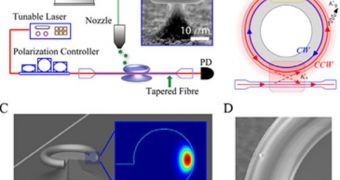As scientists working with nanoparticles know, detecting the extremely small formations can be as difficult as producing them in the first place. They have to be searched for using advanced pieces of technology, and even then there is no guarantee that they will be found. Now, experts at the Washington University in St. Louis (WUSL), led by researcher Jiangang Zhu, have developed a new method of looking for the small particles that could make this field of research run a lot smoother.
In addition to offering a potent observation tool, the new technique also has the ability to measure the number of particles in a targeted area, determine their mass, and even provide accurate measurements on their sizes. This is the first time such a complex and advanced scientific method is developed, Technology Review informs. The find is made even more important by the fact that nanoparticles are currently making their way to many industries, ranging from medicine to beauty and solar-cell manufacturing processes. As such, any improvements in how they are handled could benefit many.
Moreover, the team says, the new method could be used to accurately assess the amounts of fine particles present in the planet's atmosphere. Experts have known for a long time that vehicle exhausts spew numerous dangerous substances into the air. These chemicals can easily penetrate our bodies' defense systems, and render us unable to protect ourselves from their effects. This is especially true for fine particles that affect the lining of the lungs, causing diseases that include pulmonary cancer and asthma. These particles affect children and seniors, most of all.
The new WUSL detecting method relies on something that can best be described as a vibrating micro-mushroom, a device that is scientifically called a tiny resonating toroid. It can detect clockwise and anticlockwise waves at the same time, which is very important in distinguishing the nosies that the nanoparticles make from the stream of background data, known as noise. The number and size of particles can be inferred from the same batch of information, after the signals are processed by a computer.

 14 DAY TRIAL //
14 DAY TRIAL //